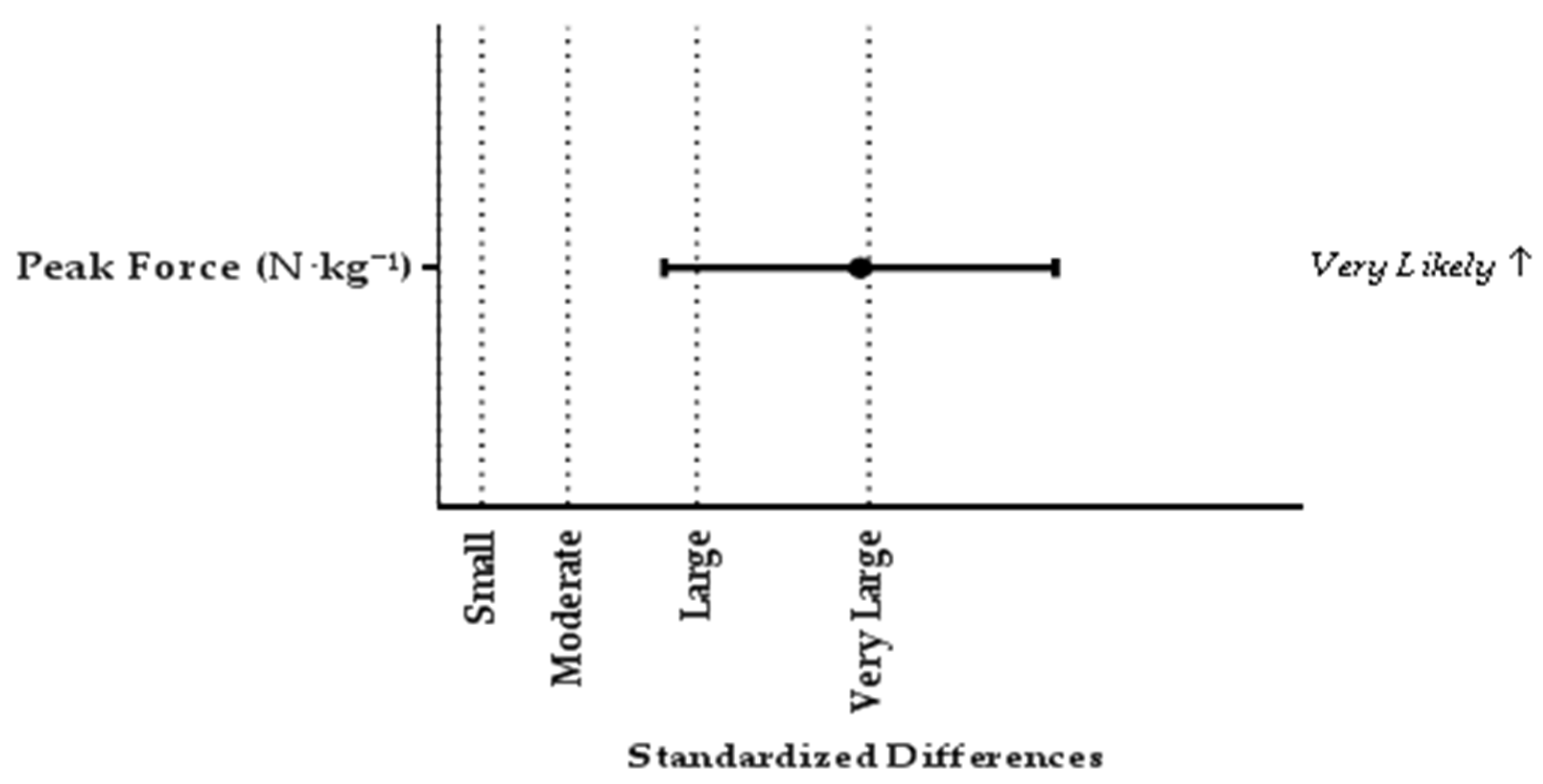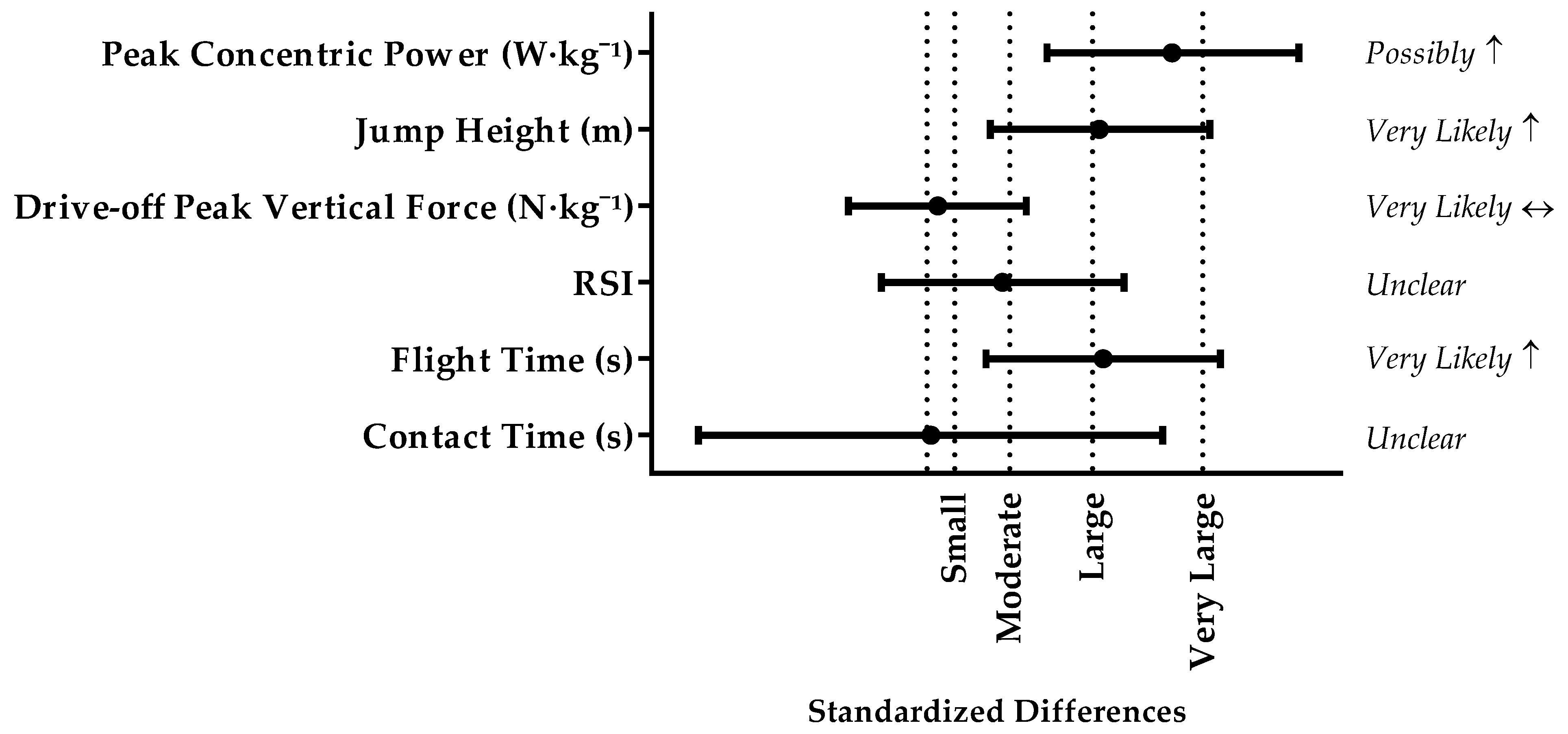Differences in Vertical Jump Force-Time Characteristics between Stronger and Weaker Adolescent Basketball Players
Abstract
:1. Introduction
2. Materials and Methods
2.1. Subjects
2.2. Procedures
2.3. Vertical Jumps
2.4. Isometric Mid-Thigh Pull
2.5. Statistical Analysis
3. Results
4. Discussion
5. Conclusions
Acknowledgments
Author Contributions
Conflicts of Interest
References
- Haff, G.G.; Stone, M.; O’Bryant, H.S.; Harman, E.; Dinan, C.; Johnson, R.; Han, K.-H. Force-time dependent characteristics of dynamic and isometric muscle actions. J. Strength Cond. Res. 1997, 11, 269–272. [Google Scholar]
- McGuigan, M.R.; Winchester, J.B. The relationship between isometric and dynamic strength in college football players. J. Sports Sci. Med. 2008, 7, 101–105. [Google Scholar] [PubMed]
- Stone, M.H.; Sands, W.A.; Carlock, J.; Callan, S.A.M.; Dickie, D.E.S.; Daigle, K.; Cotton, J.; Smith, S.L.; Hartman, M. The importance of isometric maximum strength and peak rate-of-force development in sprint cycling. J. Strength Cond. Res. 2004, 18, 878–884. [Google Scholar] [PubMed]
- McInnes, S.E.; Carlson, J.S.; Jones, C.J.; McKenna, M.J. The physiological load imposed on basketball players during competition. J. Sports Sci. 1995, 13, 387–397. [Google Scholar] [CrossRef] [PubMed]
- Abdelkrim, N.B.; Chaouachi, A.; Chamari, K.; Chtara, M.; Castagna, C. Positional role and competitive-level differences in elite-level men’s basketball players. J. Strength Cond. Res. 2010, 24, 1346–1355. [Google Scholar] [CrossRef] [PubMed]
- Chaouachi, A.; Brughelli, M.; Chamari, K.; Levin, G.T.; Abdelkrim, N.B.; Laurencelle, L.; Castagna, C. Lower limb maximal dynamic strength and agility determinants in elite basketball players. J. Strength Cond. Res. 2009, 23, 1570–1577. [Google Scholar] [CrossRef] [PubMed]
- Dawes, J.J.; Spiteri, T. Relationship between pre-season testing performance and playing time among ncaa dii basketball players. Sports Exerc. Med. 2016, 2, 47–54. [Google Scholar] [CrossRef]
- Hoffman, J.R.; Fry, A.C.; Howard, R.; Maresh, C.M.; Kraemer, W.J. Strength, speed and endurance changes during the course of a division i basketball season. J. Appl. Sport Sci. Res. 1991, 5, 144–149. [Google Scholar]
- Hoffman, J.R.; Tenenbaum, G.; Maresh, C.M.; Kraemer, W.J. Relationship between athletic performance tests and playing time in elite college basketball players. J. Strength Cond. Res. 1996, 10, 67–71. [Google Scholar]
- Spiteri, T.; Newton, R.U.; Binetti, M.; Hart, N.H.; Sheppard, J.M.; Nimphius, S. Mechanical determinants of faster change of direction and agility performance in female basketball athletes. J. Strength Cond. Res. 2015, 29, 2205–2214. [Google Scholar] [CrossRef] [PubMed]
- Spiteri, T.; Nimphius, S.; Hart, N.H.; Specos, C.; Sheppard, J.M.; Newton, R.U. Contribution of strength characteristics to change of direction and agility performance in female basketball athletes. J. Strength Cond. Res. 2014, 28, 2415–2423. [Google Scholar] [CrossRef] [PubMed]
- Suchomel, T.J.; Nimphius, S.; Stone, M.H. The importance of muscular strength in athletic performance. Sports Med. 2016, 46, 1419–1449. [Google Scholar] [CrossRef] [PubMed]
- Beckham, G.K.; Suchomel, T.J.; Bailey, C.A.; Sole, C.J.; Grazer, J.L. The relationship of the reactive strength index-modified and measures of force development in the isometric mid-thigh pull. In Proceedings of the 32th International Conference of Biomechanics in Sports, Johnson City, TN, USA, 12–16 July 2014. [Google Scholar]
- Beattie, K.; Carson, B.P.; Lyons, M.; Kenny, I.C. The relationship between maximal-strength and reactive-strength. Int. J. Sports Physiol. Perform. 2016, 12, 548–553. [Google Scholar] [CrossRef] [PubMed]
- Barr, M.J.; Nolte, V.W. Which measure of drop jump performance best predicts sprinting speed? J. Strength Cond. Res. 2011, 25, 1976–1982. [Google Scholar] [CrossRef] [PubMed]
- Barr, M.J.; Nolte, V.W. The importance of maximal leg strength for female athletes when performing drop jumps. J. Strength Cond. Res. 2014, 28, 373–380. [Google Scholar] [CrossRef] [PubMed]
- Barr, M.J.; Sheppard, J.M.; Agar-Newman, D.J.; Newton, R.U. Transfer effect of strength and power training to the sprinting kinematics of international rugby players. J. Strength Cond. Res. 2014, 28, 2585–2596. [Google Scholar] [CrossRef] [PubMed]
- Newton, R.U.; Laursen, P.; Young, W. Clinical exercise testing and assessment of athletes. Encycl. Sports Med. IOC Med. Comm. Publ. Olymp. Textb. Med. Sport 2009, 14, 160. [Google Scholar]
- Schmidtbleicher, D. Training for power events. Strength Power Sport 1992, 1, 381–395. [Google Scholar]
- Fatouros, I.G.; Jamurtas, A.Z.; Leontsini, D.; Taxildaris, K.; Aggelousis, N.; Kostopoulos, N.; Buckenmeyer, P. Evaluation of plyometric exercise training, weight training, and their combination on vertical jumping performance and leg strength. J. Strength Cond. Res. 2000, 14, 470–476. [Google Scholar]
- Sheppard, J.M.; Nolan, E.; Newton, R.U. Changes in strength and power qualities over two years in volleyball players transitioning from junior to senior national team. J. Strength Cond. Res. 2012, 26, 152–157. [Google Scholar] [CrossRef] [PubMed]
- McGuigan, M.R.; Cormack, S.J.; Gill, N.D. Strength and power profiling of athletes: Selecting tests and how to use the information for program design. Strength Cond. J. 2013, 35, 7–14. [Google Scholar] [CrossRef]
- Stone, M.H.; Sands, W.A.; Pierce, K.C.; Carlock, J.; Cardinale, M.; Newton, R.U. Relationship of maximum strength to weightlifting performance. Med. Sci. Sports Exerc. 2005, 37, 1037–1043. [Google Scholar] [PubMed]
- McGuigan, M.R.; Newton, M.J.; Winchester, J.B.; Nelson, A.G. Relationship between isometric and dynamic strength in recreationally trained men. J. Strength Cond. Res. 2010, 24, 2570–2573. [Google Scholar] [CrossRef] [PubMed]
- McGuigan, M.R.; Winchester, J.B.; Erickson, T. The importance of isometric maximum strength in college wrestlers. J. Sports Sci. Med. 2006, 5, 108–113. [Google Scholar] [PubMed]
- McGuigan, M.R.; Newton, M.J.; Winchester, J.B. Use of isometric testing in soccer players. J. Aust. Strength Cond. 2008, 16, 11–14. [Google Scholar]
- Dymond, C.; Flanagan, E.P.; Turner, A.P. The relationship between maximal strength and plyometric ability in rugby players. In Proceedings of the 29th International Conference on Biomechanics in Sports, Porto, Portugal, 27 June–1 July 2011. [Google Scholar]
- Garcia-Lopez, J.; Morante, J.C.; Ogueta-Alday, A.; Rodriguez-Marroyo, J.A. The type of mat (contact vs. Photocell) affects vertical jump height estimated from flight time. J. Strength Cond. Res. 2012, 27, 1162–1167. [Google Scholar] [CrossRef] [PubMed]
- Young, W.B.; Pryor, J.F.; Wilson, G.J. Effect of instructions on characteristics of countermovement and drop jump performance. J. Strength Cond. Res. 1995, 9, 232–236. [Google Scholar]
- Owen, N.J.; Watkins, J.; Kilduff, L.P.; Bevan, H.R.; Bennett, M.A. Development of a criterion method to determine peak mechanical power output in a countermovement jump. J. Strength Cond. Res. 2014, 28, 1552–1558. [Google Scholar] [CrossRef] [PubMed]
- Suchomel, T.J.; Bailey, C.A.; Sole, C.J.; Grazer, J.L.; Beckham, G.K. Using reactive strength index-modified as an explosive performance measurement tool in division i athletes. J. Strength Cond. Res. 2015, 29, 899–904. [Google Scholar] [CrossRef] [PubMed]
- Street, G.; McMillan, S.; Board, W.; Heneghan, J.M. Sources of error in determining countermovement jump height with the impulse method. J. Appl. Biomech. 2001, 17, 43–54. [Google Scholar] [CrossRef]
- Moir, G.L. Three different methods of calculating vertical jump height from force platform data in men and women. Meas. Phys. Educ. Exerc. Sci. 2008, 12, 207–218. [Google Scholar] [CrossRef]
- Thomas, C.; Dos’Santos, T.; Comfort, P.; Jones, P.A. Relationship between isometric strength, sprint, and change of direction speed in male academy cricketers. J. Trainol. 2016, 5, 18–23. [Google Scholar] [CrossRef]
- Comfort, P.; Jones, P.A.; McMahon, J.J.; Newton, R. Effect of knee and trunk angle on kinetic variables during the isometric midthigh pull: Test-retest reliability. Int. J. Sports Physiol. Perform. 2015, 10, 58–63. [Google Scholar] [CrossRef] [PubMed]
- Halperin, I.; Williams, K.J.; Martin, D.T.; Chapman, D.W. The effects of attentional focusing instructions on force production during the isometric midthigh pull. J. Strength Cond. Res. 2016, 30, 919–923. [Google Scholar] [CrossRef] [PubMed]
- Hopkins, W.G.; Schabort, E.J.; Hawley, J.A. Reliability of power in physical performance tests. Sports Med. 2001, 31, 211–234. [Google Scholar] [CrossRef] [PubMed]
- Holm, S. A simple sequentially rejective multiple test procedure. Scand. J. Stat. 1979, 6, 65–70. [Google Scholar]
- Cohen, J. Statistical Power Analysis for the Behavioral Sciencies; Lawrence Erlbaum Associates: Mahwah, NJ, USA, 1988. [Google Scholar]
- Hopkins, W.G. A Scale of Magnitudes for Effect Statistics. Available online: http://sportsci.org/resource/stats/effectmag.html (accessed on 14 March 2017).
- Hopkins, W.G. How to interpret changes in an athletic performance test. Sportscience 2004, 8, 1–7. [Google Scholar]
- Thomas, C.; Jones, P.A.; Rothwell, J.; Chiang, C.-Y.; Comfort, P. An investigation into the relationship between maximum isometric strength and vertical jump performance. J. Strength Cond. Res. 2015, 29, 2176–2185. [Google Scholar] [CrossRef] [PubMed]
- Kraska, J.M.; Ramsey, M.W.; Haff, G.G.; Fethke, N.; Sands, W.A.; Stone, M.E.; Stone, M.H. Relationship between strength characteristics and unweighted and weighted vertical jump height. Int. J. Sports Physiol. Perform. 2009, 4, 461–473. [Google Scholar] [CrossRef] [PubMed]
- Nuzzo, J.L.; McBride, J.M.; Cormie, P.; McCaulley, G.O. Relationship between countermovement jump performance and multijoint isometric and dynamic tests of strength. J. Strength Cond. Res. 2008, 22, 699–707. [Google Scholar] [CrossRef] [PubMed]
- Thomas, C.; Comfort, P.; Jones, P.A.; Dos’Santos, T. A comparison of isometric mid-thigh pull strength, vertical jump, sprint speed, and change of direction speed in academy netball players. Int. J. Sports Physiol. Perform. 2016, 0, 1–20. [Google Scholar] [CrossRef] [PubMed]
- Spiteri, T.; Binetti, M.; Scanlan, A.T.; Dalbo, V.J.; Dolci, F.; Specos, C. Physical determinants of division 1 collegiate basketball, women’s national basketball league and women’s national basketball association athletes: With reference to lower body sidedness. J. Strength Cond. Res. 2017. [Google Scholar] [CrossRef] [PubMed]
- Mandic, R.; Knezevic, O.M.; Mirkov, D.M.; Jaric, S. Control strategy of maximum vertical jumps: The preferred countermovement depth may not be fully optimized for jump height. J. Hum. Kinet. 2016, 52, 85–94. [Google Scholar] [CrossRef] [PubMed]



| Variable | Strong (n = 8) | Weak (n = 8) | p | d | ICC | %CV | ||
|---|---|---|---|---|---|---|---|---|
| Mean | SD | Mean | SD | |||||
| IMTP | ||||||||
| Peak Force (N·kg−¹) | 31.75 | 3.67 | 25.45 | 2.69 | 0.026 | 1.96 | 0.91 | 3.81 (2.40) |
| CMJ | ||||||||
| Time to Take-Off (s) | 0.93 | 0.16 | 0.91 | 0.14 | 0.858 | 0.09 | 0.57 | 9.12 (7.42) |
| RSImod | 0.38 | 0.09 | 0.33 | 0.04 | 0.237 | 0.63 | 0.70 | 9.46 (7.18) |
| Peak Concentric Force (N·kg−¹) | 25.56 | 1.66 | 22.84 | 1.01 | 0.013 | 1.99 | 0.83 | 2.33 (2.46) |
| Jump Height (m) | 0.34 | 0.04 | 0.30 | 0.05 | 0.150 | 0.72 | 0.98 | 1.61 (2.32) |
| Peak Concentric Power (W·kg−¹) | 53.70 | 6.68 | 46.02 | 4.74 | 0.228 | 1.32 | 0.97 | 2.38 (1.25) |
| DJ | ||||||||
| Contact Time (s) | 0.38 | 0.10 | 0.38 | 0.08 | 0.978 | 0.03 | 0.91 | 5.15 (4.59) |
| Flight Time (s) | 0.51 | 0.04 | 0.47 | 0.03 | 0.228 | 1.28 | 0.82 | 2.56 (1.88) |
| RSI | 1.42 | 0.28 | 1.28 | 0.23 | 0.289 | 0.55 | 0.89 | 5.05 (4.53) |
| Peak Concentric Force (N·kg−¹) | 30.41 | 6.57 | 30.85 | 4.35 | 0.834 | 0.08 | 0.88 | 5.24 (3.13) |
| Jump Height (m) | 0.32 | 0.05 | 0.27 | 0.03 | 0.180 | 1.25 | 0.84 | 9.09 (8.05) |
| Peak Concentric Power (W·kg−¹) | 55.92 | 4.27 | 45.42 | 7.14 | 0.052 | 1.78 | 0.84 | 5.30 (4.34) |
© 2017 by the authors. Licensee MDPI, Basel, Switzerland. This article is an open access article distributed under the terms and conditions of the Creative Commons Attribution (CC BY) license (http://creativecommons.org/licenses/by/4.0/).
Share and Cite
Thomas, C.; Kyriakidou, I.; Dos’Santos, T.; Jones, P.A. Differences in Vertical Jump Force-Time Characteristics between Stronger and Weaker Adolescent Basketball Players. Sports 2017, 5, 63. https://doi.org/10.3390/sports5030063
Thomas C, Kyriakidou I, Dos’Santos T, Jones PA. Differences in Vertical Jump Force-Time Characteristics between Stronger and Weaker Adolescent Basketball Players. Sports. 2017; 5(3):63. https://doi.org/10.3390/sports5030063
Chicago/Turabian StyleThomas, Christopher, Irene Kyriakidou, Thomas Dos’Santos, and Paul A. Jones. 2017. "Differences in Vertical Jump Force-Time Characteristics between Stronger and Weaker Adolescent Basketball Players" Sports 5, no. 3: 63. https://doi.org/10.3390/sports5030063






